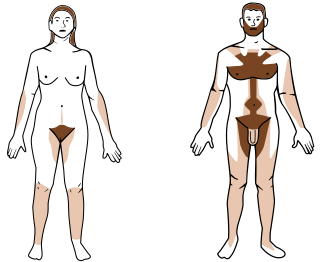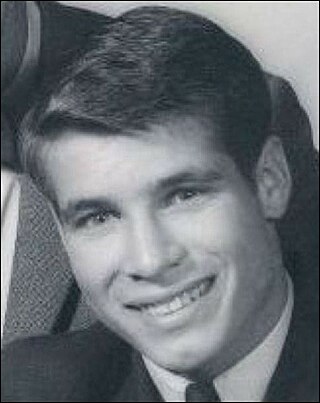
A hairstyle, hairdo, haircut or coiffure refers to the styling of hair, usually on the human scalp but sometimes on the face or body. The fashioning of hair can be considered an aspect of personal grooming, fashion, and cosmetics, although practical, cultural, and popular considerations also influence some hairstyles.

A barber is a person whose occupation is mainly to cut, dress, groom, style and shave men's and boys' hair or beards. A barber's place of work is known as a "barbershop" or a "barber's". Historically barbershops were also places of social interaction and public discourse. In some instances, barbershops were also public fora. They were the locations of open debates, voicing public concerns, and engaging citizens in discussions about contemporary issues.

Hair removal, also known as epilation or depilation, is the deliberate removal of body hair or head hair.

Shaving is the removal of hair, by using a razor or any other kind of bladed implement, to slice it down—to the level of the skin or otherwise. Shaving is most commonly practiced by men to remove their facial hair and by women to remove their leg and underarm hair. A man is called clean-shaven if he has had his beard entirely removed.

A buzz cut, or wiffle cut, is a term that is used to refer to any of a variety of short hairstyles, especially where the length of hair is the same on all parts of the head. Rising to prominence initially with the advent of manual hair clippers, buzz cuts became increasingly popular in places where strict grooming conventions applied. In several nations, buzz cuts are often given to new recruits in the armed forces. However, buzz cuts are also used for stylistic reasons.

The high and tight is a military variant of the crew cut. It is a very short hairstyle, characterized by the back and sides of the head being shaved to the skin and the option for the top to be blended or faded into slightly longer hair. It is most commonly worn by men in the U.S. armed forces. It is also popular with law enforcement officers and other public safety personnel. Although "high and tight" is the primary term used in military and law enforcement, the same haircut is sometimes referred to by civilians as a "walker".

A crew cut is a type of haircut in which the upright hair on the top of the head is cut relatively short, graduated in length from the longest hair that forms a short pomp (pompadour) at the front hairline to the shortest at the back of the crown so that in side profile, the outline of the top hair approaches the horizontal. Relative to the front view, and to varying degrees, the outline of the top hair can be arched or flattened at the short pomp front and rounded or flattened over the rest of the top to complement the front hairline, head shape, face shape and facial features. The hair on the sides and back of the head is usually tapered short, semi-short, or medium.

The mohawk is a hairstyle in which, in the most common variety, both sides of the head are shaven, leaving a strip of noticeably longer hair in the center. It is today worn as an emblem of non-conformity.

Head shaving is a form of body modification which involves shaving the hair from a person's head. People throughout history have shaved all or part of their heads for diverse reasons including aesthetics, convenience, culture, fashion, practicality, punishment, a rite of passage, religion, or style.

A flattop is a type of haircut where the hair on the top of the head is cut and styled upright to form a flat profile when viewed from the front or side.

A hair clipper, often individually called the apparent plurale tantum hair clippers, is a specialised tool used to cut human head hair. Hair clippers work on the same principle as scissors, but are distinct from scissors themselves and razors. Similar but heavier-duty implements are used to shear sheep, but are called handpieces or machine shears.

Hair fetishism, also known as hair partialism and trichophilia, is a partialism in which a person sees hair – most commonly, head hair – as particularly erotic and sexually arousing. Arousal may occur from seeing or touching hair, whether head hair, armpit hair, chest hair or fur. Head-hair arousal may come from seeing or touching very long or short hair, wet hair, certain colors of hair or a particular hairstyle. Pubephilia is sexual arousal at the sight or feel of pubic hair.

A lock of hair is a piece or pieces of hair that has been cut from, or remains singly on, a human head, most commonly bunched or tied together in some way. A standard dictionary definition defines a lock as a tress, curl, or ringlet of hair.

A queue or cue is a hairstyle that was worn by the Jurchen and Manchu peoples of Manchuria, and was later required to be worn by male subjects of Qing China. Hair on top of the scalp is grown long and is often braided, while the front portion of the head is shaved. The distinctive hairstyle led to its wearers being targeted during anti-Chinese riots in Australia and the United States.

Judaism prohibits shaving with a razor on the basis of a rabbinic interpretation of Leviticus 19:27, which states, "Ye shall not round the corners of your heads, neither shalt thou mar the corners of thy beard." The Mishnah interprets this as a prohibition on using a razor on the beard.

A brush cut is a type of haircut in which the hair on the top of the head is cut short in every dimension. The top and the upper portion of the back and sides are cut the same length, generally between 1⁄4 and 1⁄2 inch, following the contour of the head. The hair below the upper portion of the sides and back of the head is tapered short or semi-short with a clipper, in the same manner as a crew cut. A variant form may have a slight graduation of the top hair longer from back to front or a quickly graduated bit of hair at the front hairline to achieve a little flip up of the hair at the forehead. A brush that is cut at less than 1⁄4 inch on top may be referred to as a burr. A brush that is cut at 1⁄4 inch or longer on top, and especially one that shows natural curl, depending on length, may be referred to as a short brush cut or brush cut. Brush cuts are traditionally groomed with hair control wax, commonly referred to as brush wax.

The undercut is a hairstyle that was fashionable from the 1910s to the 1940s, predominantly among men, and saw a steadily growing revival in the 1980s before becoming fully fashionable again in the 2010s. Typically, the hair on the top of the head is long and parted on either the side or center, while the back and sides are buzzed very short. It is closely related to the curtained hair of the mid-to-late 1990s, although those with undercuts during the 2010s tended to slick back the bangs away from the face.

A regular haircut, in Western fashion, is a men's and boys' hairstyle that has hair long enough to comb on top, a defined or deconstructed side part, and a short, semi-short, medium, long, or extra long back and sides. The style is also known by other names including taper cut, regular taper cut, side-part and standard haircut; as well as short back and sides, business-man cut and professional cut, subject to varying national, regional, and local interpretations of the specific taper for the back and sides.

Shanghai-Style Barber Shop is a barber shop opened by a group of Shanghai barbers coming to Hong Kong mainly in the 1950s to give classical Shanghai haircuts. It is popular in Hong Kong among higher class people in the period of 1950s-1970s, offering a range of classical haircut until today. Other than hair-cutting, Shanghai style barber shops provide different unique services include trimming, massaging, nails clipping, etc. Despite the sunset of Shanghai style barber shop in Hong Kong in the modern days, it still attracts loyal customers, especially among males, and costs around HK$70 for a haircut and shave using traditional clippers.
Secular laws regulating hairstyles exist in various countries and institutions.


















